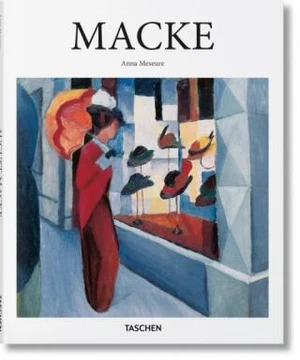Kniha: Macke; Autor: Meseure Anna; – Once nicknamed “Mister Color,” August Macke is today considered a lead figure in Weimar-era art and a pioneer of Expressionist painting. With his color-led interpretations of beauty, Macke combined facets of Impressionism, ...
Nejlevnější produkt
16,13 € | Knihy Dobrovsky | In stock
Máte ve vašem obchodě lepší produkt?
Nejlevnější produkt
16,13 € | Knihy Dobrovsky | In stock
Máte ve vašem obchodě lepší produkt?
K dispozici v
Co říkají obchody
Knihy Dobrovsky
Once nicknamed “Mister Color,” August Macke is today considered a lead figure in Weimar-era art and a pioneer of Expressionist painting. With his color-led interpretations of beauty, Macke combined facets of Impressionism, Post-Impressionism, and Fauvism into a style at once kaleidoscopic and uniquely his own. From cheerful scenes of parks to his final major work Farewell (1914), explore the full scope of his remarkable talent. August Macke (1887–1914) quickly ascended to notoriety, only to be killed at the tender age of 27 at the start of World War I. Despite his brief career, the artist left a remarkable oeuvre in his wake, his obsessions with color reflecting aspects of Impressionism, Post-Impressionism, Fauvism, and Expressionism. Through his engagement with these diverse schools of art, Macke assimilated disparate influences and approaches into a style entirely his own. Grouped with the Blaue Reiter movement, but eschewing the mysticism that often pervaded the works of its artists, Macke returned time and again to color-led interpretations of beauty, whether the kaleidoscopic watercolor Bright Women in front of the Hat Shop (1913), or the shimmering hues of Lady in a Green Jacket (1913). These colors reached their zenith in 1914 when Macke traveled with Klee and Moilliet to Tunis and became acquainted with North African light. With leading examples from his vivid painterly world, this book introduces us to Macke’s short but influential career as a pioneering Expressionist. From cheerful scenes of parks, zoos, and promenades to his final major work, ominously titled Farewell (1914), we explore a remarkable talent for visual impact and an intense pursuit of the emotional possibilities of color. Each book in TASCHEN’s Basic Art series features: a detailed chronological summary of the life and oeuvre of the artist, covering his or her cultural and historical importance a concise biography approximately 100 illustrations with explanatory captions

